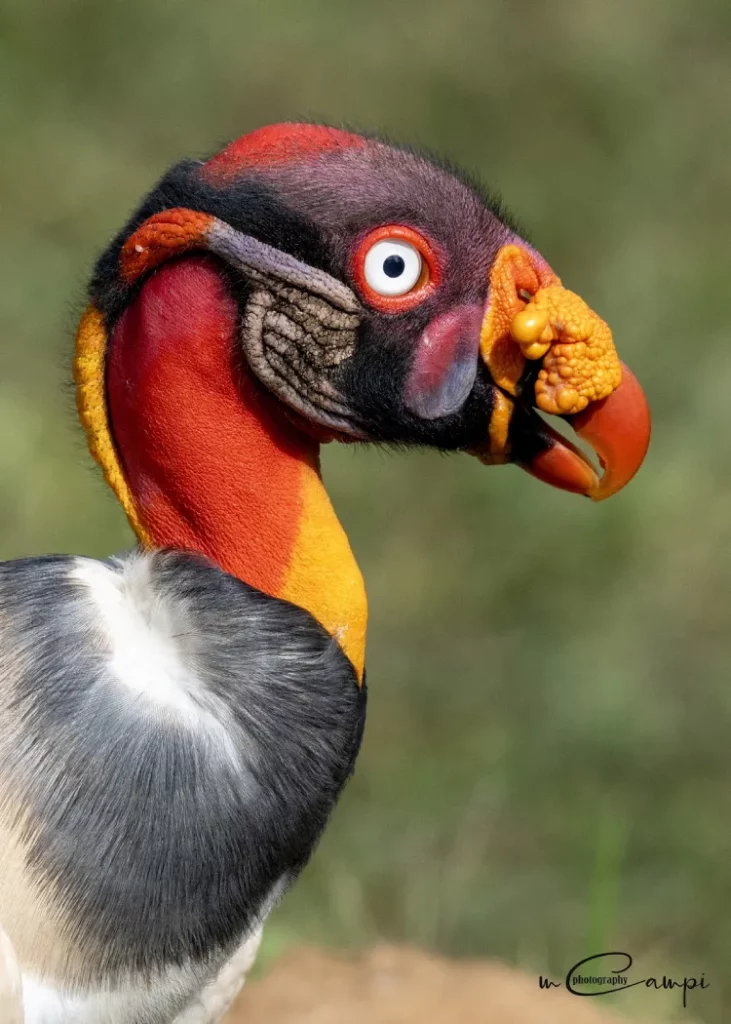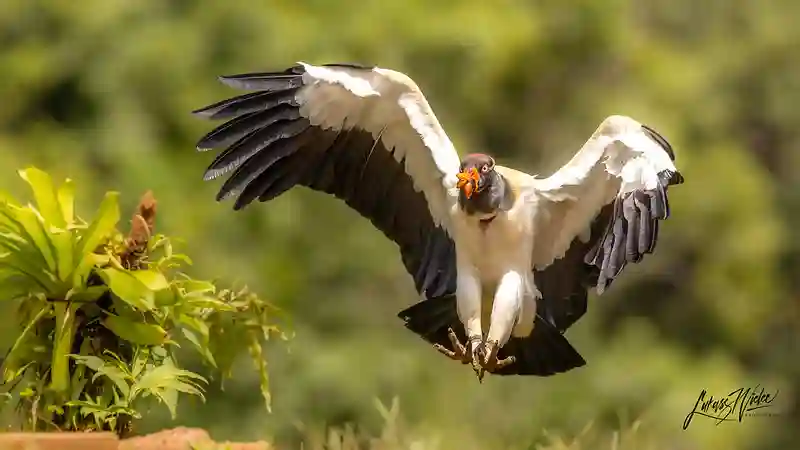King Vulture
The King Vulture, with its regal appearance and vital ecological role, is an exciting species to observe in the wild, particularly in Costa Rica's protected rainforests.

Sarcoramphus papa
Scientific Name
Cathartidae (New World Vultures)
Family
Accipitriformes
Order
Monotypic species, no recognized subspecies.
Subspecies.
Range and Habitat
Geographic Range
Found from southern Mexico through Central America (including Costa Rica) and down to northern Argentina.
Migratory Patterns
Non-migratory, though they may move locally in search of food or during dry seasons.
Preferred Habitat
Inhabits tropical lowland forests, savannas, and scrublands. Prefers dense forests but often forages in open areas.
Altitude Range
Typically found at altitudes up to 1,500 meters (5,000 feet), but may range higher.
Costa Rica Habitat
Conservation Status
Least Concern
Conservation Status
Population Status
Globally stable but facing declines in some areas due to deforestation and habitat fragmentation.
Habitat destruction, especially of tropical forests. Poisoning from chemicals used to kill predators or from toxins in carcasses.
Conservation efforts
Protected in many national parks and reserves, especially in Costa Rica. The species benefits from strong conservation programs aimed at preserving large tracts of tropical forests.
Primary Threats
Habitat destruction, especially of tropical forests. Poisoning from chemicals used to kill predators or from toxins in carcasses.
Identification
King Vulture
Rarity Level:
CommonBest Viewing Times:
Early Morning (Dawn - 8 AM), All Day
Size
67-81 cm (26-32 inches) in length, wingspan: 1.2-2 meters (4-6.5 feet) Weight: 2.7-4.5 kg (6-10 lbs)
Plumage
King Vulture adults are mostly white with a black tail and wingtips. Their head and neck are bare and vividly colored in orange, red, yellow, and purple hues.
Distinctive Features
A striking orange caruncle (fleshy growth) on the top of the beak. Large, broad wings and a hooked, powerful beak for tearing flesh.
Sexual Dimorphism
Diet and Feeding Behavior
Primary Diet
- Carrion (dead animals) is their primary food source. They feed on a variety of carcasses, including mammals, reptiles, and other birds.
Foraging Techniques
- Often the first to locate carrion, using its keen eyesight to find food from great heights. Its strong beak allows it to tear open tough hides that other vultures cannot penetrate.
Feeding Times
- Active throughout the day, often feeding in the early morning or late afternoon.
Behavior Patterns
King Vulture
Lorem ipsum dolor sit amet, consectetur adipiscing elit, sed do eiusmod tempor incididunt ut labore et dolore magna aliqua.
Social Structure
Usually seen alone or in small groups. King Vultures may be found with other species of vultures around carcasses but tend to dominate them due to their size and strength.
Song and Vocalization
Generally silent, but may make low hissing or grunting sounds when feeding or interacting with other vultures.
Courtship and Mating Ritual
Courtship involves displays where the birds bow, spread their wings, and sometimes touch bills. Pairs are monogamous and stay together for many years.
Territoriality
Not particularly territorial but will defend carrion from smaller scavengers.
Birdwatching Tips
Best Locations
In Costa Rica, best spots to see King Vultures include:
- Corcovado National Park on the Osa Peninsula.
- La Selva Biological Station and Braulio Carrillo National Park.
- Palo Verde National Park.

Best Time of the Year
King Vultures can be seen year-round, but the dry season (December to April) is often best, as carrion becomes more concentrated in fewer areas.
Common Behavior
Look for them soaring at great heights or perched on large trees near forest edges. They are often found near carcasses, alongside other vultures.
Recommended Gear
Binoculars with a wide field of view for watching soaring birds, and a spotting scope for distant perched individuals.
Breeding and Nesting Behavior
Breeding Season
Varies by region, but in Costa Rica, breeding occurs from February to May.
Nesting Sites
Nests are typically located in tree hollows or on cliffs, with minimal lining. They do not build elaborate nests like some other birds of prey.
Clutch Size
Usually a single egg.
Incubation Period
{acf_breeding_and_nesting_incubation_period}
Parental Care
Both parents participate in incubating the egg and feeding the chick. The young fledge after three to four months.
Did You Know?
How do I identify this bird?
The King Vulture is unmistakable with its large white body, black wingtips, and vividly colored, bare head. Its bright orange caruncle on the beak is another key feature.
Where is the best place to see it?
In Costa Rica, head to national parks with extensive tropical forests such as Corcovado or La Selva, where it often soars above the canopy or perches in large trees. Boca Tapada, near the Nicaragua border, is also an excellent spot to view and photograph this species.
Is this bird endangered?
No, the King Vulture is currently listed as Least Concern, but localized populations may be at risk due to habitat destruction.
Interesting Behaviors
King Vultures often take the lead when feeding on carcasses, using their strong bills to tear into flesh that smaller vultures cannot. Other vultures often wait for the King Vulture to open up the carcass before feeding.
Despite their scavenging lifestyle, King Vultures help keep ecosystems clean by consuming dead animals and preventing the spread of disease.Cultural Significance
Revered by some indigenous cultures of Central and South America as a symbol of power and mystery. In ancient Maya mythology, they were seen as intermediaries between the human world and the gods.
Stunning plumage
The chicks are born a dull gray and take 4 years to develop the striking white and black patterns of the adult birds.
Not the greatest sense of smell
Unlike his “cousins” the Turkey and Black Vultures, the King Vulture does not have a highly developed sense of smell. Instead, he relies on his cousins to find the carrion, then swoops in to use his size and power to take over the rancid meal.


